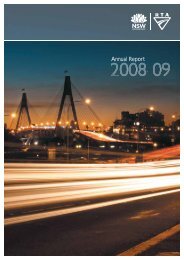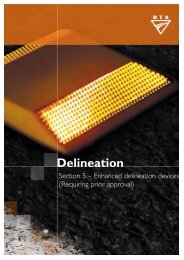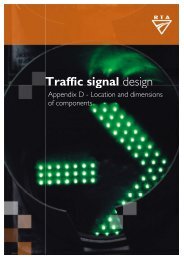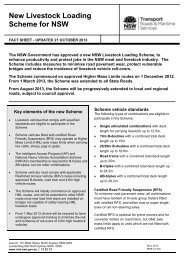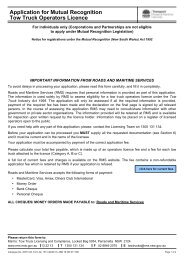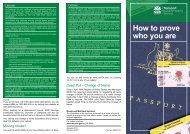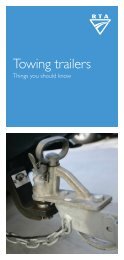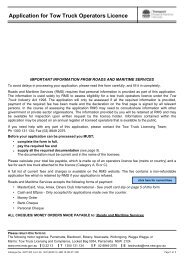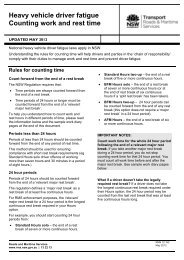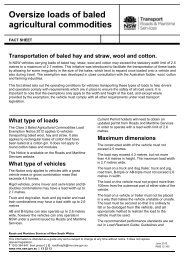Traffic Signal Design - Section 11 Detectors - RTA
Traffic Signal Design - Section 11 Detectors - RTA
Traffic Signal Design - Section 11 Detectors - RTA
You also want an ePaper? Increase the reach of your titles
YUMPU automatically turns print PDFs into web optimized ePapers that Google loves.
<strong>Traffic</strong> <strong>Signal</strong> <strong>Design</strong> – <strong>Section</strong> <strong>11</strong> <strong>Detectors</strong><br />
<strong>11</strong>.3 VEHICLE LOOP DETECTORS<br />
<strong>11</strong>.3.1 Characteristics<br />
The inductive loop detector has proved to be the most reliable vehicle detector. This consists<br />
of two parts - a loop and a sensor unit. The loop consists of two to four turns of wire in a<br />
special pattern installed in saw slots up to 80 mm deep in the road surface. These loops are<br />
connected to the sensor units, which are normally located in the controller.<br />
The sensor units energise the loops with a high frequency signal from 20 kHz to100 kHz. This<br />
sets up an electromagnetic field in the vicinity of the loop. When a metallic object (such as a<br />
vehicle) passes over the loop, it causes a change in inductance. The sensor unit detects this<br />
and passes a signal to the controller's detector input. The principle is the same as that used in<br />
many metal detectors, i.e. when a metallic object enters an electromagnetic field, the field is<br />
disturbed.<br />
The detection area is approximately equal to the loop area. The loop area is less sensitive to<br />
some vehicles e.g. motorcycles or vehicles with a proportion of non-metal components. The<br />
sensor unit can be automatically self adjusting. As the sensitivity is increased vehicles outside<br />
the loop area (e.g. in adjacent lanes) are likely to be detected when they should not be<br />
detected. The more sensitive it is to vehicles the more sensitive the loop becomes to<br />
environmental factors such as temperature, rain and electromagnetic fields.<br />
<strong>11</strong>.3.2 Installation and location<br />
Generally detectors should be located as shown in Appendix D Location & Dimensions of<br />
Components. Installation methods for stop-line and advance loop detectors are shown on<br />
drawings No. VC005-17 and No. VC005-18, respectively.<br />
When locating detectors the following points should be considered in regard to installation:<br />
• does the pavement in the vicinity of the detector need resurfacing or reconstructing<br />
(loop wire is vulnerable to damage, but needs to be close to the road surface for<br />
optimum sensitivity)<br />
• loops cannot be installed over any bridges, culverts, stormwater drains or similar<br />
structures unless there is at least 80 mm of covering pavement<br />
• loops cannot be installed closer than 300 mm to any ferrous metal object such as a<br />
manhole cover or pipe<br />
• the distance between the loop and the sensor unit (normally located in the<br />
controller) is limited to about 300 metres.<br />
The location and/or size of any detector may be varied to suit special circumstances such as<br />
geometry, location of expansion joints or ferrous metal objects. In the latter case electrical<br />
officers should be consulted before determining the location and/or size of any detector.<br />
Stop-line detectors should not be located on the departure side of the stop line. Clearances<br />
shown in Appendix D Location & Dimensions of Components must not be reduced. Settingout<br />
details must be shown for any detector which is not located in accordance with minimum<br />
clearances to pavement marking and kerbs.<br />
<strong>11</strong>.3.3 Modes of operation<br />
The sensor units for vehicle loop detectors can be operated in one of two modes - passage<br />
mode or presence mode.<br />
<strong>11</strong>-2 Version 1.3<br />
UNCONTROLLED WHEN PRINTED



